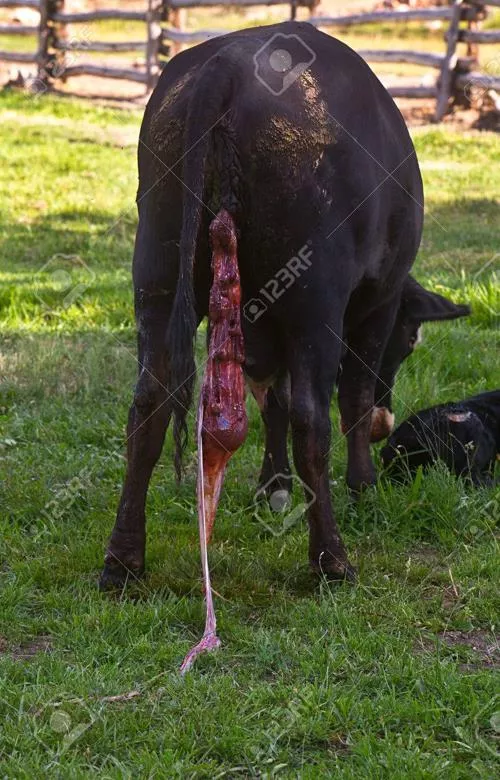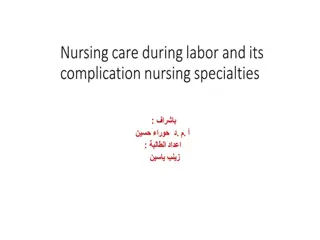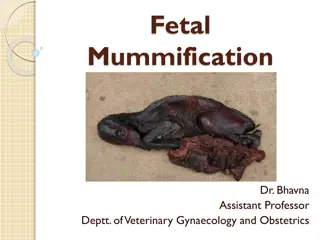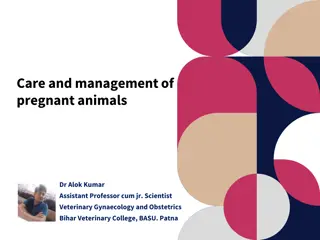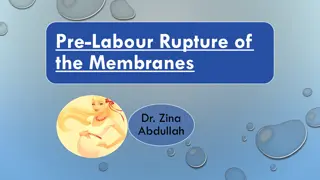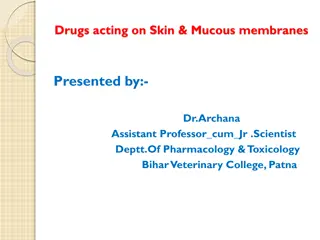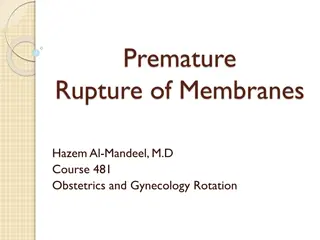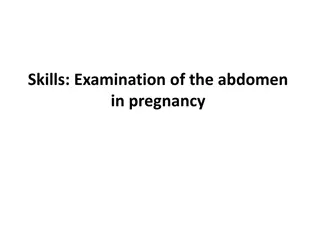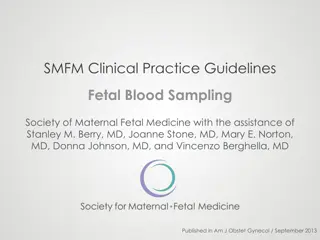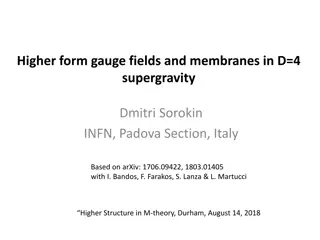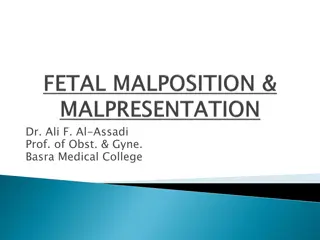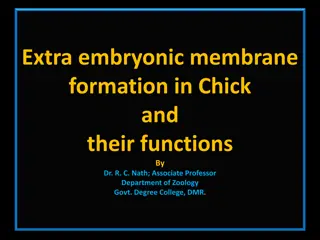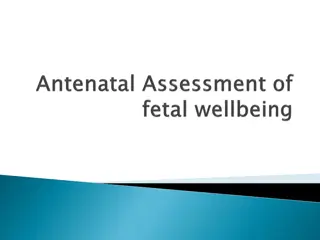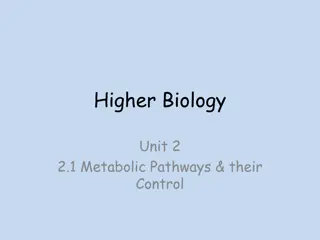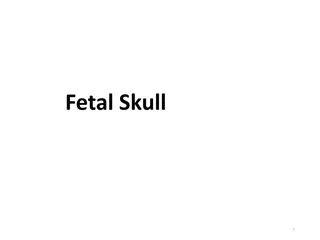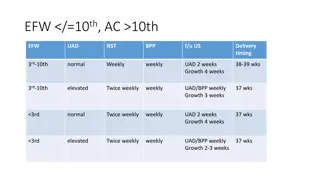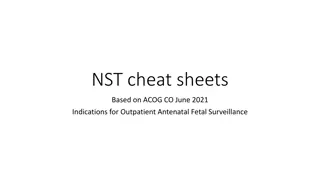Understanding Retention of Fetal Membranes in Veterinary Obstetrics
Retention of fetal membranes, a common issue during the third stage of labor, has significant consequences for animals, especially cattle. Causes include insufficient expulsive efforts and placental issues. The incidence ranges from 6.8% to 50%, often associated with dystocia and twin births. Factors predisposing to this condition include abortion, gestational abnormalities, and uterine inertia. Recognizing and managing these factors are crucial in veterinary obstetrics.
Download Presentation

Please find below an Image/Link to download the presentation.
The content on the website is provided AS IS for your information and personal use only. It may not be sold, licensed, or shared on other websites without obtaining consent from the author. Download presentation by click this link. If you encounter any issues during the download, it is possible that the publisher has removed the file from their server.
E N D
Presentation Transcript
RETENTION OF FETAL MEMBRANES Dr. Bhavna Asstt. Prof. Deptt. Of VGO
Introduction The expelled during the third stage of labor. fetal membranes are normally The membranes are said to be retained whenever the third stage of labor is prolonged beyond its normal duration.
Occurs common consequences may be most serious in the mare. in in all the species, dairy particularly cow but its In polytocous species (sow, bitch & queen), may be retention of one or more fetuses. associated with
Causes Three main factors: 1. Insufficient expulsive efforts by the myometrium. 2. Failure of placenta to separate from the endometrium inflammatory changes, immaturity, hormonal immune deficiencies). 3. Mechanical obstruction partial closure of the cervix). (may be due placental imbalance, to (including
Cattle Mostly cattle shed placenta within 6 hours after parturition. Said to be retained if not shed even at 12-24 hours. RFM is a recurrent considerations of endometritis-pyometra diseases. An important contributor infertility due predisposition to uterine infections. theme metritis- complex in the of to bovine role to its in
Incidence Overall incidence is 6 8%. 25 50% associated with dystocia. 30 50% of twin births are associated with RFM.
Physiologic processes leading to the detachment of the placenta in cattle. Beagley et al. 2010
Factors which predispose to retained fetal membranes Abortion, especially associated with placentitis. Abnormal (prolonged or shortened) gestation length. Dystocia, primary uterine inertia, delivery by caesarean section Fatty liver (predisposes to uterine atony) Deficiencies of selenium/vitamin E /vitamin A Failure of placental maturation - Twin births and induced calvings Heat stress Abnormalities of oestrogen: progesterone ratio in late gestation
Clinical Features Membranes (normally visible hanging from vulva) become progressively more decomposed, have contaminated with faeces and soil. Reduced appetite and milk yield. Retention followed obstetric interference supervened by severe metritis and toxaemia within 2-3 days which can be fatal, if not treated timely. fetid odour, by extensive may be
Effects on subsequent fertility Increased incidence of endometritis. Once metritis is developed, leads to economic losses due to increase in days open, services per conception, calving to first estrus interval and days from calving to first service and reduced conception rates to first service.
Treatment Manual practised but is contraindicated as it is detrimental to the cow. removal, though commonly Can result in damage of endometrium, leading to haemorrhage and infection. If the animal has fever, uterine damage increases the risk of septicaemia and perimetritis.
Ecbolic agents Oxytocin @ 40-60 IU intramuscularly, if used immediately after calving. PGF and its analogues have direct effect on the placentomes.
Antibiotics Rationale behind using antibiotics is to prevent or treat metritis. Systemic antibiotics can be used. Ceftiofur @2.2mg/kg intramuscularly for 5 days.
Local/intrauterine antibiotics reduce odour but reduce putrifaction of membranes and level of intrauterine phagocytosis prolonging retention. the rate of thus, Tetracyclines cause irritation and pH damage to endometrium. Intrauterine pessaries are inactivated in the presence of debris present in the uterus.
Collagenase Infusion of collagenase into the stumps of the umbilical arteries for correcting the lack of cotyledon proteolysis. Bacterial collagenase (200,000 IU) from Clostridium histolyticum dissolved in 1 L of saline is infused.
Prevention Providing cow comfort. Reducing stress around parturition. Careful including supplementation of cows with Vitamin E and selenium during transition period in the deficient areas. nutritional management
Mare One of the most common peripartum problems in mare. Average time taken 1 hour Should not exceed 2 hours Should be treated as an emergency.
Incidence Usually 2 - 10.6% 28% after fetotomy 50% after caesarean section
Clinical signs Presence of a variable portion of tissue protruding from the vulva. Complications include - acute metritis, septicaemia, laminitis and even death.
Treatment Oxytocin @ 20 40 IU intramuscularly, can be repeated after 1 hour if membranes are not expelled. Alternatively, slow intravenous infusion of 50 IU oxytocin in 1 L of physiological saline over 1 hour.
Manual removal Can be tried but very carefully. The hanging part is grasped and twisted into a rope. The gloved hand anointed with lubricant is gently introduced along the 'rope' to the area of circumferential attachment in the uterus. As the 'rope' is gently pulled and twisted, the tips of the fingers are pressed between the endometrium and the chorion.
Unwanted side-effects of this manual removal may be serious haemorrhage, invagination of one of the horns and a higher chance of retention of microvilli in the endometrium. The consequences of difficult removal are increased puerperal containing much endometritis and spasm and delayed involution of the uterus. exudate, debris; uterine tissue laminitis;
Another treatment is placement of 10 L of warm saline inside chorioallantoic membrane. Stretching of uterine wall stimulates uterine contraction separation of placenta. Should be used in combination with exogenous oxytocin administration. leading to Collagenase @ 200,000 IU in 1 L saline can be infused into umbilical arteries.
After care Flushing and siphoning the uterus once or twice daily for a few days using warm, sterile physiological saline should be used in 2-4 litre flushes (until the recovered fluid is clear). NSAIDS for treating laminitis, if any. Systemic antibiotics in case of toxic metritis. COX inhibitors like flunixin meglumine can be given to treat endotoxaemia.

 undefined
undefined









